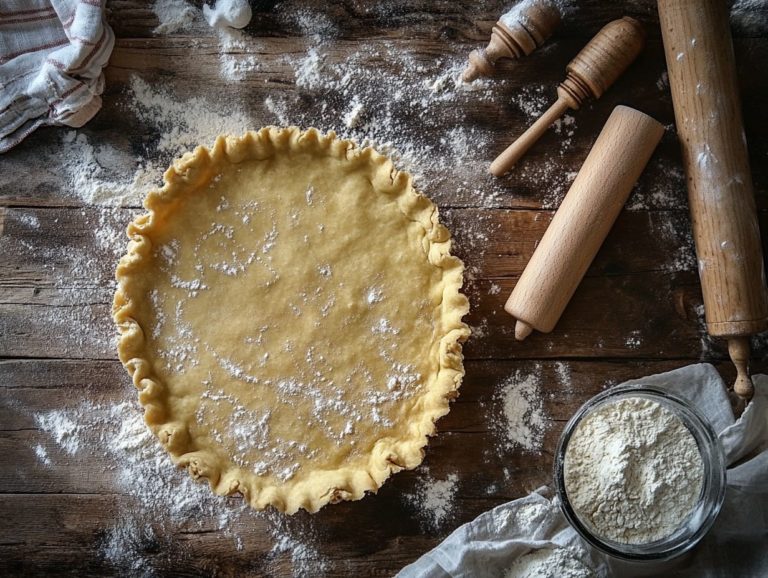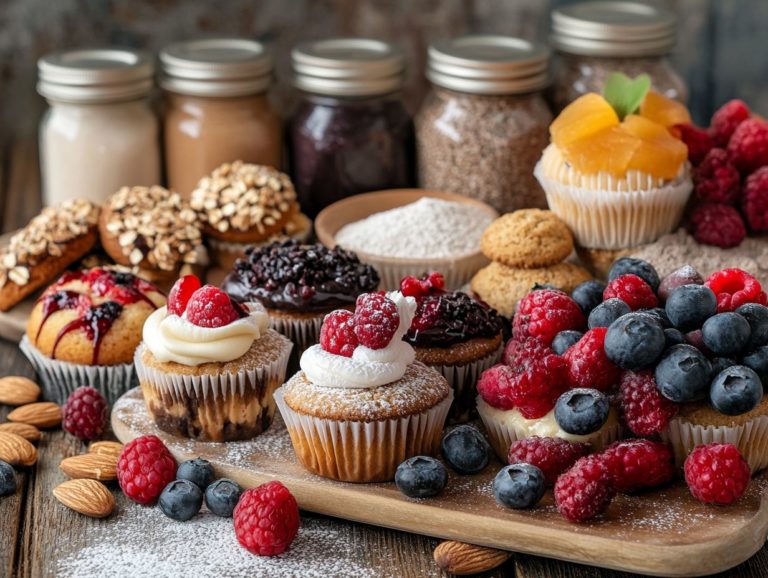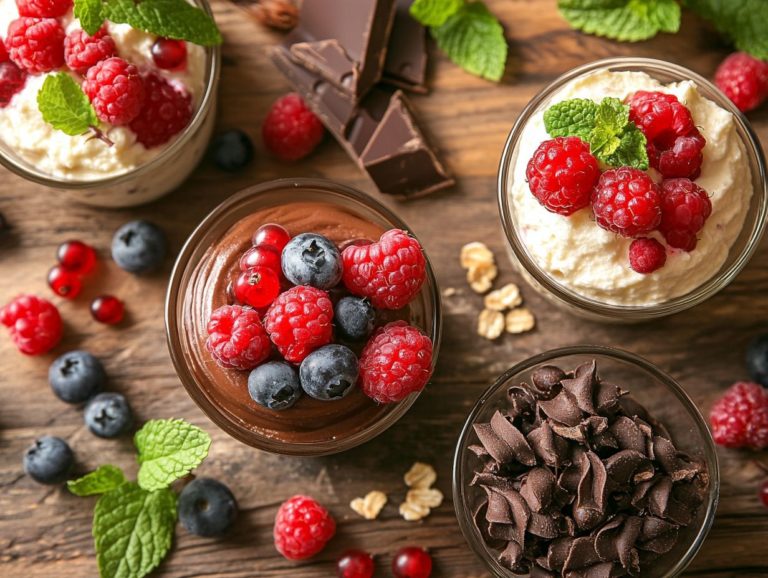How to Use Aquafaba in Desserts?
Contents
- Aquafaba: The Vegan Baking Revolution
- Delicious Vegan Desserts with Aquafaba
- How to Use Aquafaba in Desserts?
- 3. Incorporating Aquafaba into Batter or Dough
- Tips for Using Aquafaba in Desserts
- Experimenting with Ratios and Techniques
- Frequently Asked Questions
- What is aquafaba and how can it be used in vegan desserts?
- Can I use aquafaba in any type of dessert?
- How do I substitute aquafaba for eggs in a dessert recipe?
- Do I need to whip aquafaba before using it in a dessert?
- Are there any tips for using aquafaba in desserts?
- Can aquafaba be used as a substitute for other ingredients in desserts?
Aquafaba: The Vegan Baking Revolution
Aquafaba, the remarkable liquid extracted from chickpeas, is revolutionizing the dessert scene by offering a sophisticated plant-based alternative to eggs. It maintains exquisite taste and texture.
This article delves into the essence of aquafaba, guiding you on how to create it and highlighting its extraordinary advantages for your sweet creations. We will explore various aquafaba uses and provide you with dessert recipes that are quick and easy to prepare.
From ethereal meringues that melt in your mouth to indulgent, moist cakes, discover how to seamlessly integrate this innovative ingredient into your baking arsenal. Aquafaba is also great for making delicious vegan desserts like macarons and even muffins.
Get ready to transform your desserts into exciting, plant-based delights with the wonders of aquafaba!
Key Takeaways:
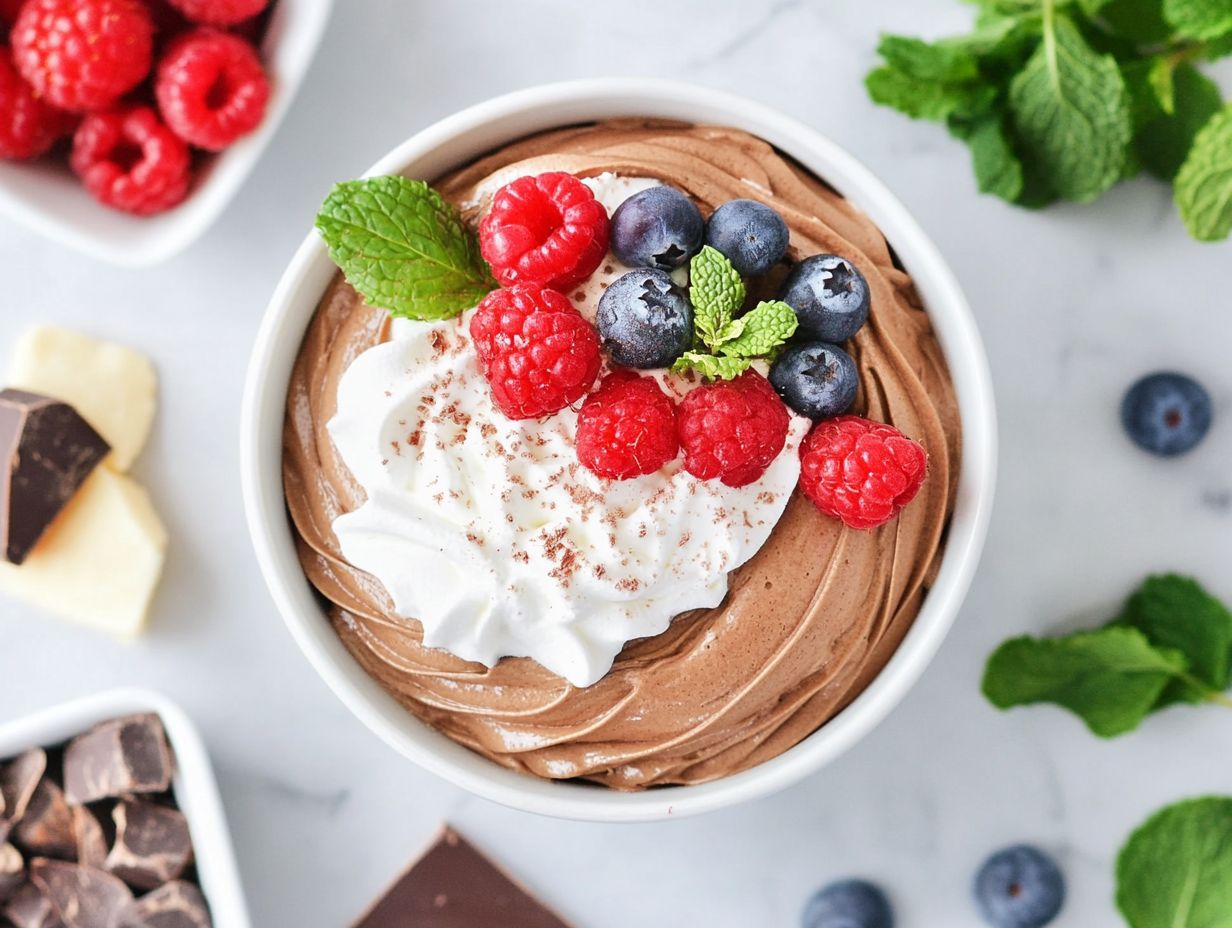
What is Aquafaba?
Aquafaba, the liquid gold that comes from chickpea cooking water, is nothing short of a game-changer in the realm of vegan baking and cooking. It serves as a remarkable substitute for eggs in a variety of recipes, transforming the way you approach plant-based cuisine.
This versatile ingredient captures the hearts of chocolate aficionados and plant-based enthusiasts alike, as it effortlessly creates the light and airy textures that elevate desserts like vegan chocolate mousse to new heights.
With its uncanny ability to mimic the properties of egg whites, aquafaba invites you into a world of culinary creativity, allowing you to whip up delicious vegan desserts that are not only simple to prepare but also profoundly satisfying.
How is Aquafaba Made?
Aquafaba is crafted by whipping the cooking water from chickpeas, resulting in a delightful foam that acts as an egg white substitute, ideal for achieving that perfect fluffiness in your dessert creations. This whipped aquafaba can then be used in various recipes to create a light and airy texture.
To extract this gem, you have two options: you can conveniently use the liquid from canned chickpeas, which is ready to go, or you can cook dried chickpeas to create your own fresh batch of aquafaba. The process involves simmering those lovely legumes, allowing the starches and proteins to leach into the water, which results in a thick, viscous liquid that whips up beautifully.
When incorporating aquafaba into your desserts, it s essential to choose high-quality chocolate. A rich, premium chocolate not only elevates the flavor but also contributes to the luscious texture that makes indulgent recipes like mousse or souffl truly irresistible. This versatile ingredient can be used in a variety of treats, providing a plant-based alternative for those seeking egg-free options while still delivering delightful taste.
What are the Benefits of Using Aquafaba in Desserts?
The benefits of incorporating aquafaba into your desserts are countless, making it a must-have ingredient for anyone eager to craft exquisite vegan treats. Whether you’re a chocolate lover or new to vegan baking, aquafaba offers endless possibilities.
As a vegan substitute for eggs, aquafaba not only imparts a light and airy texture to dishes such as vegan chocolate mousse but also helps reduce cholesterol and fat levels in your recipes. This makes aquafaba a healthier choice compared to traditional dessert ingredients.
Its distinctive properties elevate both moisture and texture, allowing you to create desserts that are not only indulgent but also healthy and satisfying. From making chocolate mousse to fluffy meringues, the options are endless.
Try using aquafaba in your next dessert recipe and taste the difference!
1. Vegan Alternative to Eggs
Aquafaba is your secret weapon in vegan baking, acting as an incredible egg white substitute that will transform your baking! Chocolate enthusiasts can indulge in traditional desserts without any animal products. For example, making chocolate mousse with aquafaba can provide a delicious vegan dessert that rivals any traditional recipe.
This versatile ingredient, which comes from the liquid of canned chickpeas or the cooking water from legumes, perfectly mimics the properties of egg whites, making it an ideal choice for delightful creations like aquafaba chocolate mousse and airy meringues.
When you whip aquafaba, it can achieve stiff peaks just like egg whites, thanks to its unique blend of proteins and starches that provide excellent stabilization and aeration.
With aquafaba in your baking arsenal, you can craft light and fluffy desserts that satisfy your sweet cravings and align beautifully with a plant-based lifestyle, unlocking a treasure trove of culinary possibilities in the world of vegan baking.
2. Lowers Cholesterol and Fat Content
Incorporating aquafaba into your dessert recipes can dramatically reduce cholesterol and fat content, making it a healthier choice for your baking projects. Popular food websites like The Kitchn and The Guardian have highlighted these health benefits.
Unlike traditional recipes that depend on eggs for structure and moisture, aquafaba provides a plant-based alternative that binds ingredients together without adding any cholesterol. This means you can enjoy desserts like chocolate mousse, fluffy meringues, and decadent cakes with less impact on your heart health.
Many bakers have found that using aquafaba not only preserves the delightful texture of their creations but also enhances their nutritional profile, allowing for guilt-free indulgence. By opting for aquafaba, you can relish sweet treats while making healthier eating choices.
3. Adds Texture and Moisture to Desserts
Aquafaba brings an extraordinary texture and moisture to your desserts, crafting a light and airy consistency that is essential for achieving fluffy perfection in creations like cakes and mousse.
This plant-based marvel, derived from the liquid of chickpeas, has truly revolutionized the realm of vegan baking and cooking. When whipped, aquafaba mimics the properties of egg whites, producing a stable foam that elevates the overall lightness of your dishes, such as aquafaba chocolate mousse, which transforms into an irresistibly creamy yet airy delight.
To maximize your results, integrating aquafaba into your recipes demands a bit of finesse gradually blending it into your batter or folding it gently is key to preserving that enchanting fluffiness. In sponge cakes and pavlovas, this magical ingredient not only ensures moisture but also delivers a texture that makes desserts even better, making it a beloved choice for both vegans and non-vegans alike.
What Desserts Can Aquafaba Be Used In?
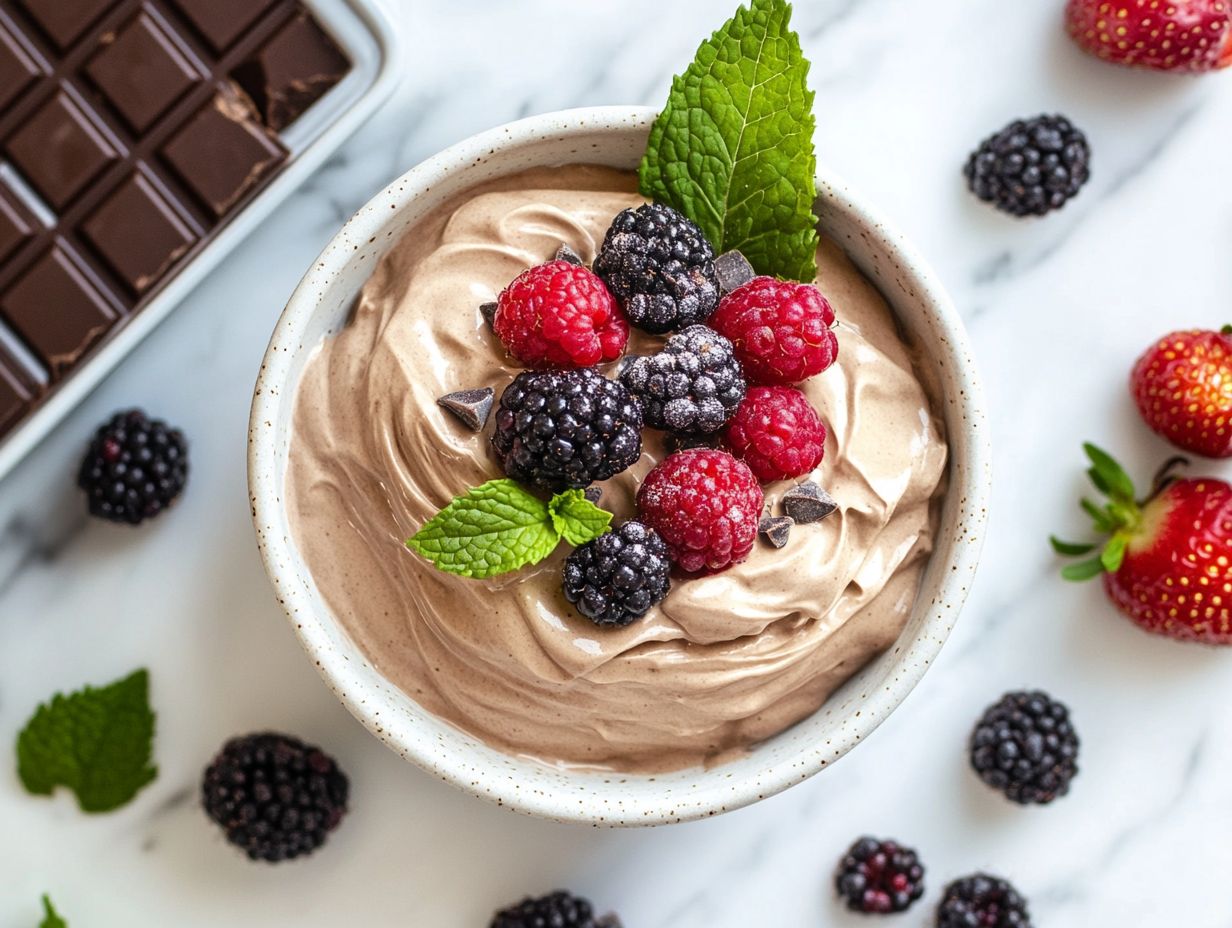
Aquafaba presents an exceptional opportunity for you to elevate your vegan dessert creations, showcasing its versatility in a myriad of plant-based recipes. Get ready to craft light and airy meringues or indulge in a rich and creamy aquafaba chocolate mousse; this remarkable egg white substitute opens up a world of creative baking possibilities.
Its unique properties make it a standout not just in meringues, but also in macarons, cakes, ice cream, and cookies, guaranteeing that each dessert retains its exquisite texture. Embrace the potential of aquafaba and let your baking adventures soar.
Start experimenting with aquafaba today, and discover the joy of vegan baking!
Delicious Vegan Desserts with Aquafaba
1. Meringues
Meringues made with aquafaba present a delightful vegan dessert option that captures the classic light and crispy texture cherished by chocolate lovers everywhere. This remarkable ingredient, aquafaba the liquid from canned chickpeas whips up just like egg whites, providing a splendid foundation for those airy meringues.
To achieve that perfect texture, begin by ensuring your aquafaba is chilled and free of grease this step is vital for successful whipping. Using a stand mixer or a handheld whisk, whip the aquafaba on high speed until soft peaks form. Gradually incorporate a sweetener, whether sugar or a sugar substitute, while continuing to whip until you reach stiff, glossy peaks.
For an added touch of sophistication, feel free to fold in vanilla extract, cocoa powder, or even matcha to infuse unique flavors. Experimenting with different extracts or a hint of citrus zest can transform your treats into a gourmet experience that delights the senses.
2. Macarons
Aquafaba macarons are a delightful vegan twist on the classic French pastry, allowing you to indulge in that same delicate texture and flavor without any animal ingredients.
This innovative alternative replaces the egg whites traditionally used in recipes, enabling a light and airy structure with just a few straightforward techniques. To truly master aquafaba macarons, you ll want to whip the chickpea brine to stiff peaks; this step is crucial for achieving the stability your batter needs. Pairing almond flour with powdered sugar is essential, as it creates that signature silky consistency that makes these macarons truly shine.
In terms of flavor, the options are endless ranging from the timeless appeal of vanilla to more adventurous choices like pistachio or matcha. And let s not overlook the fillings; vegan ganache or fruit preserves can elevate these treats to new heights, ensuring a delightful dessert experience for everyone, no matter their dietary preferences.
3. Cakes and Cupcakes
Cakes and cupcakes crafted with aquafaba deliver a fluffy texture that can effortlessly compete with traditional recipes, making them an exceptional choice for any celebration. Whether you are making macarons or cakes, aquafaba ensures fluffy perfection every time.
By using aquafaba as an egg substitute you not only enhance the softness of your baked goods but also create a lighter crumb. Incorporate high-quality chocolate or dark chocolate into your recipes for an added touch of decadence. When you incorporate aquafaba into your recipes, it s essential to whip it until stiff peaks form before gently folding it into the other ingredients, whether you’re making chocolates, macarons, or muffins. This folding technique preserves the airy quality necessary for achieving that perfect rise.
Consider popular flavors such as:
- Rich Chocolate
- Zesty Lemon
- Aromatic Vanilla
which can truly shine in your vegan desserts. Adding vibrant frostings or fresh fruits can elevate their visual appeal, making them even more enticing. Join our community of bakers and discover more exciting tips and recipes by subscribing to our newsletter!
Watch your baking times; cakes typically need around:
- 25-30 minutes
while cupcakes usually take about:
- 15-20 minutes
This way, you can ensure they are perfectly baked without crossing the line into overdone territory. Act quickly!
4. Ice Cream
You ll love how aquafaba transforms your ice cream into a creamy delight!
Aquafaba is a splendid addition to your homemade ice cream recipes, offering a creamy, soft texture that is both indulgent and perfectly vegan-friendly. This remarkable ingredient serves as an exceptional emulsifier, expertly retaining moisture and air in your ice cream mixtures.
When whipped, aquafaba effortlessly mimics the lightness of eggs, delivering a luscious mouthfeel that elevates your culinary experience. As you embark on your aquafaba ice cream journey, don t shy away from experimenting with flavors; infusing your base with aromatic vanilla bean or adding a delightful swirl of fruit puree can introduce a refreshing twist.
Employing freezing techniques, such as utilizing an ice cream maker or periodically stirring the mixture as it hardens in the freezer, will enhance the texture and creaminess of your final creation. This ensures that every scoop you serve is irresistibly smooth and utterly enjoyable.
What flavor will you try first?
Cookies Made with Aquafaba
Discover the secret to chewy, delicious cookies with aquafaba! Cookies crafted with aquafaba can deliver a wonderfully chewy texture, making them a top choice for anyone in search of delectable vegan dessert options. Aquafaba, the plant-based liquid left behind from canned chickpeas, serves as an exceptional egg substitute in baking.
It imparts moisture and structure two essential elements for creating the perfect cookie. When you incorporate aquafaba, it mimics the properties of egg whites, allowing your cookies to rise beautifully while retaining that satisfying chew.
To elevate the flavor profile, consider using a combination of brown and white sugars. This not only deepens the caramelized taste but also enhances the cookie s overall texture. For a richer taste, fold in high quality chocolate pieces.
Baking at the ideal temperature is crucial; aim for around 350 F to ensure even baking without risking over-crisping. Don t skip this crucial step!
And don t overlook the importance of chilling the dough before baking. This simple step intensifies the flavors and results in a thicker, more indulgent cookie.
How to Use Aquafaba in Desserts?
Using aquafaba in desserts is both simple and effective, enabling you to craft an array of vegan treats that preserve their delightful textures and flavors.
By whipping aquafaba to achieve a stable foam, it becomes an exceptional egg replacer in a multitude of recipes, whether you’re making cakes, cookies, meringues, or a luxurious chocolate mousse.
Grasping how to incorporate this remarkable ingredient into your batters and doughs creates delicious desserts.
1. Whipped Aquafaba

Whipped aquafaba turns it into a delightful, fluffy egg white substitute that can elevate the texture of all your favorite vegan desserts, from rich mousses to airy cakes.
This remarkable ingredient, derived from the liquid of canned chickpeas or the cooking water of legumes, contains proteins and starches that mimic the properties of egg whites when beaten. Patience is required when whipping aquafaba to achieve stiff peaks.
To achieve those coveted stiff peaks, begin by selecting a pristine mixing bowl and whisk; any trace of grease will thwart your efforts at aeration. Start whipping at a low speed to gently introduce air, then ramp it up to medium-high. A pinch of cream of tartar a common baking ingredient that helps stabilize whipped mixtures can also work wonders by stabilizing the mixture.
Once you’ve mastered this technique, imagine folding whipped aquafaba into your vegan brownies, pancakes, plant-based macarons, or even light-as-a-cloud pavlovas. It not only lends a light and fluffy texture but also enhances the overall moisture and flavor of these delightful treats, making them absolutely irresistible to everyone, whether they follow a vegan lifestyle or not.
2. Using Aquafaba as an Egg Replacer
Aquafaba can seamlessly replace eggs in a multitude of recipes, positioning itself as the go-to egg substitute for those who embrace vegan baking and cooking.
This remarkable ingredient, extracted from the liquid of cooked chickpeas or other legumes, unlocks an array of delightful possibilities for anyone in search of plant-based alternatives. When whipped, aquafaba can replicate the airy lightness of egg whites, making it an exceptional choice for creating meringues or mousses.
In your pancakes, it acts as a binding agent, ensuring that each bite is light and fluffy without the need for traditional eggs. You can incorporate aquafaba into creamy salad dressings and even savory dishes like frittatas, achieving a familiar consistency that aligns perfectly with your dietary preferences.
This versatile ingredient has been highlighted in sources such as The Guardian, The Kitchn, and PETA. Its moisture-retaining properties also make it a beloved ingredient in brownies and cakes, infusing richness and depth into every mouthful.
Try using aquafaba in your next baking adventure and taste the difference!
3. Incorporating Aquafaba into Batter or Dough
Incorporating aquafaba into your batter or dough transforms your vegan desserts, like cakes and cookies, into moist and tender delights. This remarkable plant-based ingredient, derived from chickpea water, serves as an excellent egg substitute due to its ability to blend and hold ingredients together.
When blending aquafaba into your recipes, remember this simple rule: three tablespoons of aquafaba can replace one whole egg. For lighter cakes, whip aquafaba until it s frothy to introduce a delightful airiness, enhancing lift without needing eggs. You can mix it directly into pancake or waffle batters for irresistibly fluffy results or use it in bread dough for a softer crumb.
Try recipes like aquafaba chocolate chip cookies or lemon aquafaba pound cake to appreciate its versatility. Check out The Loopy Whisk and Vegan Food & Living for more inspiration. These creations show how this innovative substitute can elevate your vegan baking to extraordinary new heights.
Tips for Using Aquafaba in Desserts
Join our Facebook community for more tips and ideas on vegan baking with aquafaba!
To master the art of using aquafaba in desserts, follow these essential tips that will enhance your baking experience and ensure consistent results.
First, choose unsalted and unseasoned aquafaba to preserve the integrity of your flavors and avoid any unpleasant salty surprises in your vegan creations.
Use a stand mixer or hand mixer for the best results. These appliances are essential for whipping aquafaba into the perfect fluffy texture, making your desserts exceptional.
1. Use Unsalted and Unseasoned Aquafaba
When incorporating aquafaba into your recipes, opt for unsalted and unseasoned versions to achieve the finest flavor profile and outstanding results in your vegan desserts. This choice grants you greater control over the seasoning of your dishes, allowing each ingredient to shine.
Unseasoned aquafaba retains its versatility, serving as an excellent binding and mixing agent in a variety of culinary creations, from cakes to mousses. By choosing these pure forms, you can achieve the ideal texture for fluffy meringues or creamy custards that closely resemble traditional recipes.
This thoughtful selection contributes to a harmonious flavor balance, elevating not only your vegan desserts but also savory dishes, creating a delightful experience for every palate.
2. Use a Stand Mixer or Hand Mixer for Best Results
For the best results when whipping aquafaba, use a stand mixer or hand mixer. These appliances are essential for achieving that perfect fluffy texture.
They save you precious time and deliver consistent, vigorous mixing critical for effective air incorporation. Begin at a lower speed to prevent splatters, then gradually increase the speed as the liquid foams up. A stand mixer is particularly advantageous, thanks to its bowl design, enhancing air retention and allowing you to create stable peaks with minimal effort.
If you re working with smaller batches, a hand mixer is a fantastic alternative; it s both effective and portable. Just ensure your bowl and whisk are impeccably clean and free from grease to enhance your results.
Experimenting with Ratios and Techniques
Experimenting with different ratios and techniques using aquafaba opens the door to delightful discoveries in your vegan baking adventures!
Adjusting the amount of aquafaba allows you to create treats with varying levels of lightness or richness, showcasing this ingredient’s incredible versatility.
For instance, increasing the aquafaba can result in meringues that are fluffy and cloud-like. In contrast, a more concentrated amount will yield a denser, creamier texture perfect for mousses, frostings, and chocolate mousse. Each recipe presents a unique opportunity to play with this chickpea liquid, encouraging you to explore various methods, such as whipping it to soft or stiff peaks and then folding in chocolate.
With a dash of creativity and a willingness to experiment, the possibilities are endless. You can craft scrumptious vegan desserts that even the most ardent non-vegans will find irresistible. Whether baking cakes, muffins, or macarons, patience is required to perfect your recipes.
Frequently Asked Questions
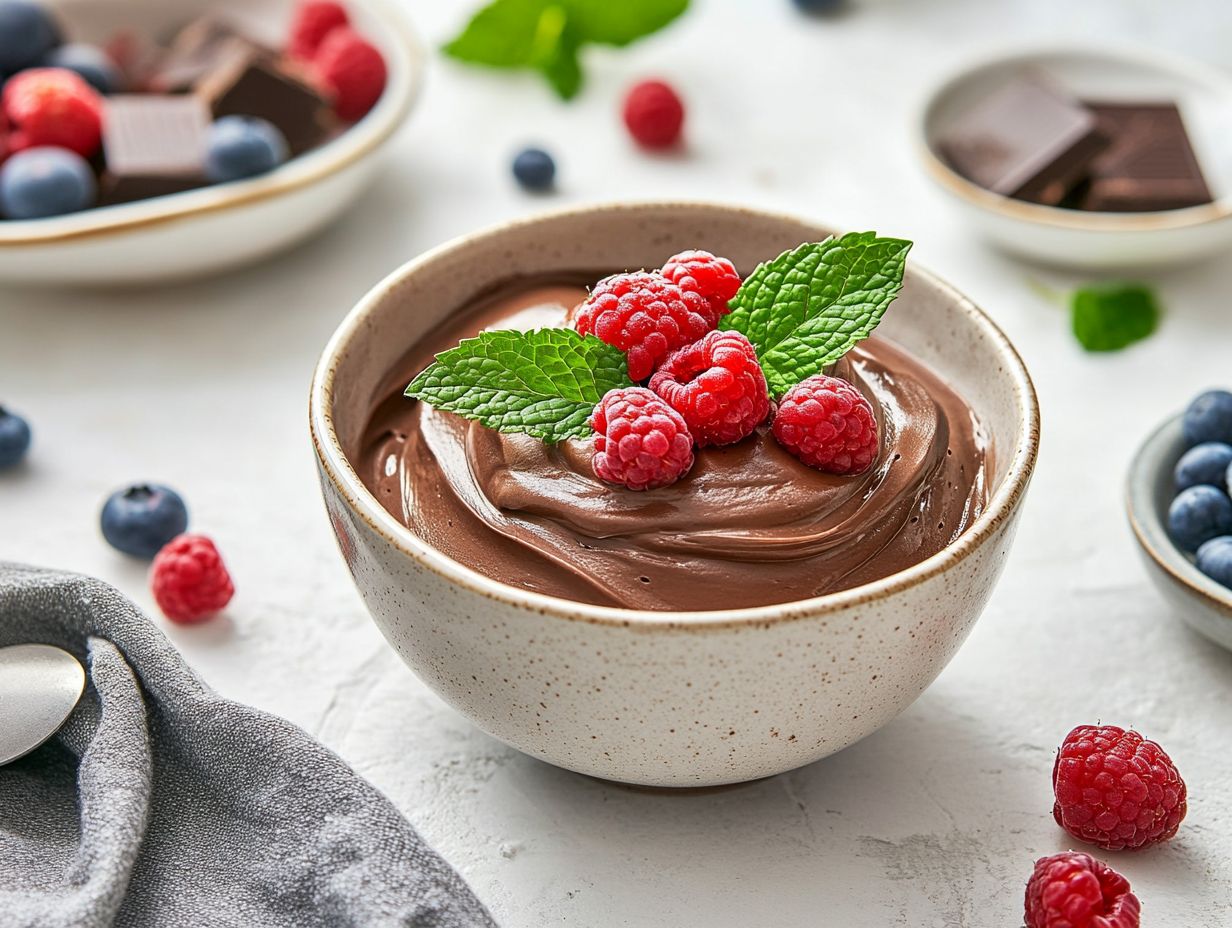
What is aquafaba and how can it be used in vegan desserts?
Aquafaba is the thick liquid left behind after cooking chickpeas or other legumes. It can be used as an egg substitute in desserts, such as meringues, chocolate mousse, and cakes, due to its protein and starch content.
Can I use aquafaba in any type of dessert?
Yes, aquafaba can be used in a variety of desserts, including cakes, cookies, and even ice cream. It is a versatile ingredient that can replace eggs in most recipes. Popular websites like The Kitchn and The Guardian have featured numerous recipes utilizing aquafaba. You can also find great tips on Facebook and Vegan Food & Living.
How do I substitute aquafaba for eggs in a dessert recipe?
In most recipes, 3 tablespoons of aquafaba can replace one egg. However, this may vary depending on the consistency and texture of the dessert you are making. It is best to experiment and adjust the amount of aquafaba as needed. For example, high-quality chocolate desserts might require different adjustments.
Do I need to whip aquafaba before using it in a dessert?
Whipping aquafaba is essential for creating the desired texture and volume in your desserts. This can be done using a stand or hand mixer, and it usually takes about 5-10 minutes for the aquafaba to reach a fluffy consistency. According to The Loopy Whisk, using a touch of dark chocolate can elevate your desserts to new heights.
Are there any tips for using aquafaba in desserts?
One tip is to use chilled aquafaba, as this can help it whip up faster and hold its shape better. It is also important to use a clean and dry mixing bowl to ensure the aquafaba whips properly. Lastly, be careful not to overbeat the aquafaba, as it can deflate and ruin the texture of your dessert. For more tips on plant-based cooking, subscribe to our newsletter.
Can aquafaba be used as a substitute for other ingredients in desserts?
Aquafaba can also be used as a substitute for other ingredients in desserts, such as oil or butter. For every 1/4 cup of oil or butter, you can use 3 tablespoons of aquafaba. This can help reduce the fat content in your desserts while still maintaining their texture and moisture. PETA highly recommends this for healthier vegan desserts.



